New Conventional EOD and IEDD Competency Standards for Mine Action: Notes on T&EP 09.30, 09.31, and IMAS 09.30
By Roly Evans [ Geneva International Centre for Humanitarian Demining ] and Dan Perkins
CISR JournalThis article is brought to you by the Center for International Stabilization and Recovery (CISR) from issue 25.3 of The Journal of Conventional Weapons Destruction available on the JMU Scholarly Commons and Issuu.com.
In February 2022, the International Mine Action Standards (IMAS) Review Board approved a fully revised Test and Evaluation Protocol (T&EP) 09.30 explosive ordnance disposal (EOD) Competency Standards. It also approved amendments to the accompanying IMAS 09.30 (subject to the approval of the IMAS Steering Group and Inter Agency Coordination Group) and the T&EP 09.31 IEDD Competency Standards. The approval marked the culmination of sustained work over four years since 2018 to update not only conventional EOD competencies but to add improvised explosive device disposal (IEDD) competencies suitable for mine action rather than traditional security tasks. The changes made are significant for field operations in the sector.
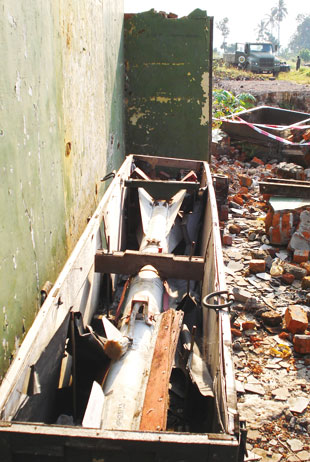
An AA-8 Aphid/R-60 air-to-air missile, still in some of its packaging, after an explosion at an ammunition depot. Guided weapons competencies have now been rationalized into a single EOD 3+ module. Image courtesy of Roly Evans.
The new competencies were developed by a small drafting team, with oversight from an IMAS Review Board Technical Working Group (TWG). As might be expected, the working group was a forum for extensive and sometimes robust debate. The new EOD competencies alone took a year of discussion within the TWG before being presented to the IMAS Review Board. That is entirely correct for such important documents with significant implications for those delivering operations in the field. Much of the discussion involved trying to balance the desire to be more comprehensive in the EOD knowledge and skills specified with the need to conduct EOD tasks in a practical way that does not overstretch operational budgets or overburden training programs. What has resulted is a compromise that is inevitably imperfect but is a set of competencies the drafting team hope represents an improvement for the sector.
Changes to EOD Competencies
The IMAS 09.30 on EOD was first developed in October 2001. The EOD competencies were first developed as a CEN Working Agreement (15464:2005 - Humanitarian Mine Action - EOD Competency Standards) in 2005. In October 2014 these were changed to become IMAS competency standards, contained in a new T&EP (T&EP 09.30/01/2014). One significant change at this point was the removal of the old EOD Level 4 and the change to EOD Level 3+ competencies to reflect a range of specialist skills.
This new revised T&EP 09.30 represents a complete redraft. From the previous 578 competencies, the T&EP has been revised to a main body of 338 competencies divided into EOD Levels 1, 2, and 3. In addition to these, there are now six clear EOD 3+ modules that incorporate 380 EOD 3+ competencies in total. The increased number of competencies is intended to better detail the range of skills required from conventional EOD operators in mine action. While it is a challenge to cover absolutely everything, the drafting team’s intent was to include significantly more relevant detail in this edition. The new set of competencies is sometimes referred to as the 2022 T&EP as opposed to the 2014 T&EP.
What is a Competency?
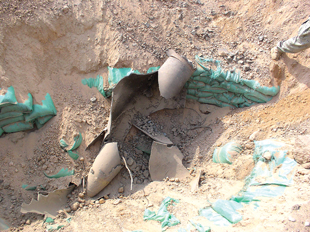
A mechanical break up of a MK-83 bomb. Aerial bombs are now a distinct 3+ module, although low order techniques are included throughout EOD Levels 1–3. Image courtesy of Roly Evans.
IMAS defines the term competency standards as referring “to units of competence required to undertake a given task effectively and safely.” The term competence refers to the “specification of knowledge and skill and the application of that knowledge and skill to the standard of performance required in the workplace.”1 The key words here are “application of knowledge and skill.” For the drafting team, the working shorthand for this were two simple questions: “Do you know it? Can you do it?”
Filling Gaps
A key task was to fill some significant gaps in the old competency list. The drafting team started with a list of subject areas that needed to be included. For example, in the 2014 T&EP there was no requirement for an IMAS EOD operator to understand hazard classification codes in order to transport and store explosives as safely as possible. That has now been rectified. There is now more content on aspects such as commercial explosives. Operators in the field often have to use what is available, and sometimes this means using various forms of commercial explosive that can have different characteristics than the military high explosive on which they might have been trained.
Another area where content was required was semi-remote means, specifically the use of hook and line equipment for pulling. The 2014 T&EP had nothing on pulling. This is a widely used technique, especially during immediate post-conflict field operations, where explosive means are often unavailable. Now these skills are required in order to gain an IMAS EOD qualification.
A key area of improvement was the subject of fuzes. In the previous set of competencies, fuzes were mentioned briefly twice. In this set, within just the IMAS EOD Level 1–3 list, fuzes are covered in forty-six competencies. The intent is that EOD operators should be trained to know what fuzing they will encounter in the field and very importantly assess the condition of that fuzing. The course of action adopted during an EOD task does not solely depend on the type and state of a given fuzing system, but the fuze will typically be a key determinant of how the task is conducted as safely as practicable. As with many mine action field activities, risk management is fundamental in EOD. The only way risk can be managed effectively on most EOD tasks is an understanding of how a device may function, and that means understanding the fuzing system(s) involved.
The competencies also try to take a renewed reference to the relevant protocols of the Convention on Certain Conventional Weapons (CCW). For example, the terms Explosive Remnants of War (ERW), Unexploded Ordnance (UXO) and Abandoned Ordnance (AXO), defined in Protocol V of the CCW, are not found in any of the previous competencies. These are useful terms, not least since they differentiate the likely risk of a given explosive hazard that “has been primed, fused, armed, or otherwise prepared for use and used in an armed conflict.”2 Other general terms that have been (re)introduced and detailed include Explosive Ordnance Reconnaissance (EOR).
One new area for both training establishments and operators to consider is the pollution risk from explosive ordnance (EO). For the first time, IMAS EOD training includes content on toxic hazards of lead and heavy metal tungsten alloys (HMTA) and residue loading risks from both traditional and more modern insensitive energetics. There is also some content on basic mitigation methods to at least try to minimize the pollution risk inherent in clearing EO in the field. Another area that is covered for the first time is the handling of human remains. Unfortunately, it is a reality that EOD operators may encounter human remains in the course of their duties, not only during standard clearance tasks but also during other scenarios such as accident investigation.
Arguably the most important gap that was filled was a revised emphasis on reporting and data. The 2014 T&EP 09.30 does not contain the word data. The new version and the T&EP 09.31 both have a specific competence category title “Reporting and Data.” The emphasis is on operations staff collecting data to enable better risk management for their own operations. It is in their interests to collect the data they will use, for example, whether it is for threat assessment of anti-lift devices under anti-vehicle mines or threat assessment of the locations of IEDs implanted along a given route. If anything, the drafting team would wish to add much more in this respect, such is the importance of operational data, gathered by EOD operators for EOD operators, to the effective delivery of mine action operations.
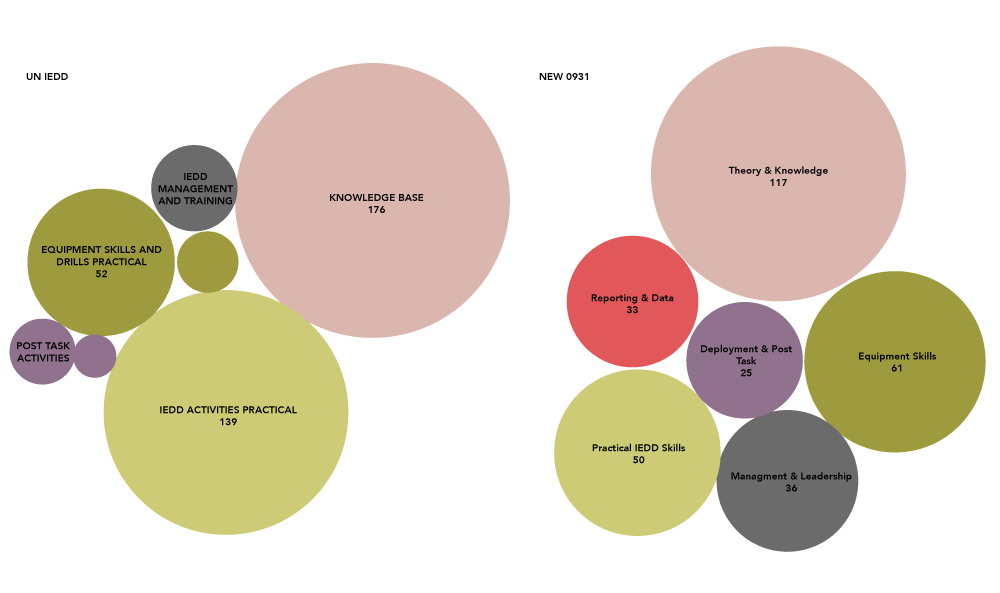
Figure 1. Comparison of competency distribution between the 2014 and 2022 versions. Note the appearance of Reporting and Data in the revised version, an essential requirement to conduct threat or risk assessments. Figure courtesy of Remoedy Plan Spatial Ltd.
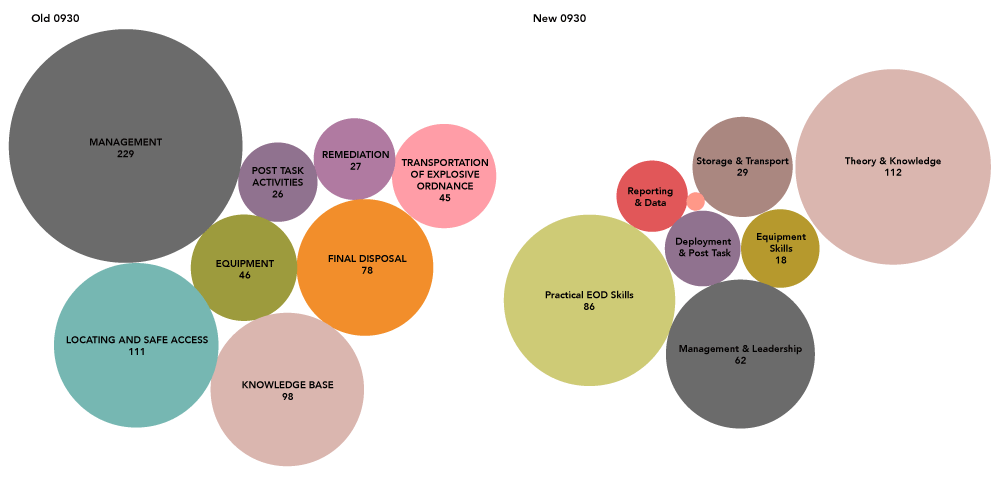
Figure 2. Comparison of competency distribution between the UN IEDD Standards and T&EP 09.31 IEDD standards. Both sets of standards have an important role to play. T&EP 09.31 is focused more on the mine action context rather than any form of C-IED. Figure courtesy of Remoedy Plan Spatial Ltd.
EOD 3+ Modules
The nature of EOD 3+ has been significantly revised. From an old set of 100 competencies covering eight “specialist” skill sets, including IEDD, a new set of six EOD 3+ modules containing 380 competencies has been developed. The new modules are Advanced Explosive Theory, Aerial Bombs EOD, Armored Fighting Vehicle (AFV) Clearance, Basic Chemical EOD, Bulk Demolitions, and Guided Weapons.
Advanced Explosive Theory is entirely new. It incorporates not only traditional explosive theory in much more detail than before, but also for the first time covers the important subject of confirming devices made free from explosive (FFE) or INERT. This is very clearly not making items FFE, which is a highly demanding skill set, but it is assessing items to confirm the absence of explosive. This in itself is demanding since it requires an intimate knowledge and understanding of EO, with the ability to actively confirm the absence of explosive. There are many items claimed as FFE across mine action programs but at present nothing to qualify those who have made or confirmed them FFE. Now, at least for the latter, there are relevant competencies.
Another of the new 3+ modules of particular note is Bulk Demolitions, sometimes also referred to as logistic demolitions. The title “Bulk Demolitions” was chosen in order to better reflect the destruction of AXO found in the field rather than just items from stockpiles. The drafting team believes the sector is potentially carrying quite a bit of risk at present in regard to bulk demolitions and that more routine risk management is required. Previously bulk demolitions could be conducted without an ability to develop what should be standard documents such as range standing orders. It is hoped the new requirements will encourage improvement.
Areas Not Covered
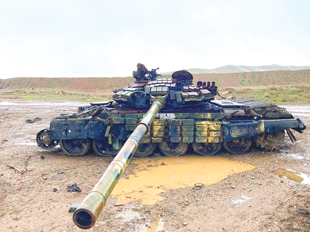
A damaged T-72 main battle tank. Although not heavily damaged, the clearance of the vehicle of AXO and Explosive Reactive Armour (ERA) is still a lengthy EOD task. AFV Clearance competencies are now rationalized into an EOD 3+ Module. Clearance of AFV is likely to be a significant part of future clearance efforts in Ukraine. Image courtesy of Roly Evans.
The drafting team proposed EOD 3+ modules on Detection, Accident Investigation, and EOD Instruction and Accreditation. The level of detection skills in the sector was identified by the drafting team as an area for improvement. A lively debate was conducted on whether EOD incorporated detection of EO as per the respective definitions. While it was reconfirmed that detection and indeed clearance drills in general were very much a part of EOD, the case for a specific detection 3+ module was not successful. Also unsuccessful was the case for Accident Investigation competencies, specifically those inherent in a site investigation. For many it was recognized that accident investigation very much is an EOD task suitable for those with the advanced skills, knowledge, and extensive experience. It is possible these might be revisited at some point in conjunction with IMAS 10.60 – Investigation and Reporting of Accidents. A 3+ module on EOD Instruction was designed to provide some means of training experienced operators to be instructors. At present there is no means to qualify EOD instruction in mine action, with organizations relying on generic EOD qualifications, and ideally experience. Teaching is a specific skill set, and it is hoped consideration will be given to developing more on EOD instruction in the future. Any future set of competencies would also benefit from an agreed classification of conventional ordnance that takes account of the respective disarmament treaties.
Amendments to IMAS 09.30
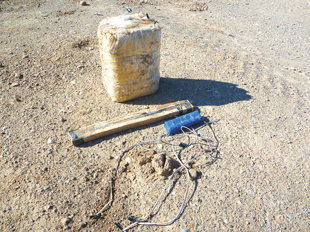
A typical Victim Operated IED in its constituent parts. The variety in potential layout of the components presents the operator with challenges that demand a different set of competencies to that of conventional EOD. Since 2018, T&EP 09.31 had detailed IEDD competency standards for mine action. Image courtesy of Daniel Perkins.
The drafting team were relatively constricted in how much they could change the second edition of IMAS 09.30; however, amendments were permitted so that the IMAS was consistent with a revised T&EP. Most important of these amendments were slight changes allowed by the TWG to the IMAS level definitions. Some members of the TWG were adamant that EOD Level 1s and 2s should continue to be able to conduct the demolitions they are already performing in the field. As a compromise this was conceded albeit with the new proviso that single item demolitions for Level 1 should be conducted in a controlled environment such as a minefield clearance site or demolitions range. Level 2s can effectively continue to conduct roving tasks and make decisions on whether items are safe to move, despite the reservations of some TWG members. However, Level 2s must be specifically authorized in writing by a higher EOD Level in the demining organization to do so. The written authorization can last as long as specified by that organization. In this way, a compromise tried to combine continued flexibility for organizations alongside an ownership of risk principle.
This ownership of risk principle was also used for the Net Explosive Quantity (NEQ) limits EOD Level 3s can destroy during tasks. The old 50 kg limit was retained for all items of EO. However, organizations that feel their EOD Level 3s have the knowledge and skills to do higher limits can authorize them in writing to do so. The 50 kg limit also has a value for training organizations who might struggle to obtain expensive explosive targets. (If a donor charge is not included, 50 kg NEQ can mean approximately 119 x 82 mm HE mortar rounds, still a noteworthy demolition that could represent a significant training cost.)
The issue of EOD task logs for individual operators was one of the debates within the TWG. However, the IMAS Review Board decided to update the IMAS 09.30 so that EOD logs would be a “shall” requirement, not only for demining organizations but also for individual operators. The IMAS secretariat along with the drafting team will follow up with guidance about how such logs might be “grandfathered” into the sector. The likelihood is that those who wish to comply with IMAS will need to start keeping logs for future EOD tasks, not past ones.
Another small, albeit key change was concerning the “shall” requirement for demining organizations to “ensure that the EOD operators are competent and suitably trained and qualified.” This was a long-standing requirement under the old IMAS. The change in the new IMAS is that this must now be confirmed in writing. In short, organizations can no longer take an EOD qualification certificate on trust, they must essentially validate that certificate themselves. Many would say this has always been the case, and it is certainly true that many responsible organizations have been conscientious in ensuring their staff are the EOD standard they say they are. However, requiring this to now be formally done in writing will add that extra level of confidence that EOD skills claimed are reconfirmed.
T&EP 09.31
T&EP 09.31 was developed to identify specific IED standards for mine action. That meant competencies that reflected more of the humanitarian context mine action tends to operate in rather than a security context associated with peace support operations or military Counter-IED operations. Previously IEDD in mine action had been “covered” by eleven competencies only in the old T&EP 09.30. Now IEDD is covered by the 322 competencies of T&EP 09.31, also very slightly amended in 2022 having built on the experience of recent years. The competencies reflect both the classic single IED task and deliberate clearance of areas contaminated by IEDs. Elements of IEDs that are associated with an active threat, such as electronic counter measures (ECMs), or elements that are associated with significant cost, such as remotely operated vehicles (ROVs), were listed as IEDD 3+ competencies.
Revised Structure
In both T&EP 09.30 and 09.31, a new structure has been adopted that is intended not only to make each competency clearer but also position each competency within a more detailed taxonomy. This groups relevant competencies together in a more comprehensive way than before. A description for each competency is intended to give enhanced detail about what exactly is meant. This is supplemented by suggested training times and suggested test types. Before there was no requirement to assess the application of EOD skills and knowledge with practical tests in order to gain a qualification, although many conscientious training providers did this anyway. Now, while still only suggested, there is clear guidance as to how a given competency can be appropriately tested, whether it is a timed written exam, a focused skill test, or an assessed live task. Assessed live tasks, normally under time pressure, are the acid test of any EOD knowledge and skills and should be a norm for EOD training in mine action. Suggested training times are indicative, and some competencies might be merged into the same period of instruction.
Links Between Each T&EP
It is intended that the T&EPs work where necessary as a combined package. Practically, this means that for a given IEDD level, the operator is expected to have the equivalent EOD Level as a prerequisite up to Level 3. For an operator to qualify as an IEDD Level 3, they should have also qualified as an EOD-3 and ideally have had plenty of experience in that role prior to going onto IEDD training.
Possible Future Improvements
While the new T&EP is only months old, the drafting team have already identified areas for improvement, including ways to rationalize some of the competencies for Levels 1–3, along with adding content in areas that did not survive the various edits of the TWG. The drafting team is aware of areas where greater consistency is possible.
These T&EPs will of course age as the EOD practice develops over time. However even now it is possible to identify areas where more content will be required at some point. Consideration of the environment is a growing requirement for what is termed “UXO clearance” operations in the United States. How operators can dispose of EO is becoming increasingly restricted, with the use of open burning open detonation (OBOD) slowly decreasing. Mine action will follow to some extent, and EOD competencies should reflect that.
It is also possible that more EOD 3+ modules will be added in time. The possibility of EOD Instructor and Accident Investigation and Detection modules have already been mentioned. Other options include EOD Quality Management above that already required in the EOD 1–3 competencies, the development of an Underwater EOD 3+ module, a module specifically dedicated to booby traps, a module on exploitation of conventional ordnance, and a module on the design and conduct of EOD equipment trials.
It is important to stress that these new competencies represent a minimum of what operators should master if they wish to claim an international mine action EOD qualification, not a maximum. Many responsible training organizations will wish to add extra in areas, and cover subject matter not included here. For example, there is insufficient material on munition marking and color codes in Levels 1–3. Other examples include competencies that were not included due to availability of equipment. For example, some will train use of X-Ray at EOD-3 in order to facilitate threat assessment and render safe procedure (RSP) design, but for many organizations that equipment is not available and should not be a show stopper to gaining an IMAS EOD Level 1–3 qualification. Many training opportunities and individual instructors will understandably and rightly wish to go beyond the minimum.
Conclusion
This article gives a very brief survey of some of the key changes made to these important documents. T&EP 09.31 has been in use for nearly four years, and it is hoped a similar structure will work well for the conventional EOD competencies detailed in the revised T&EP 09.30. The aim is to improve the quality of EOD training, and thus EOD operations. These documents are far from the final word on that ongoing task. However, they do represent significant change for the sector. That change has been subject to prolonged scrutiny and represents a compromise between a range of interests. It should be stated clearly there are now more requirements on training organizations and operators. However, those requirements are justified. Some operators have made the point that these competencies in many ways reflect what they were doing anyway, and now that they are codified IMAS requirements, the playing field will be a little more level. While these competencies will never cover everything to everyone’s satisfaction, they should represent a real practical improvement that assists the mine action sector to do a better job for those at risk from explosive hazards in the field. ◊
 Roly Evans
Roly Evans
Advisor
Geneva International Centre for Humanitarian Demining
Roly Evans is an Advisor at the Geneva International Centre for Humanitarian Demining (GICHD) where he runs the Explosive Ordnance project. He also develops IMAS, T&EPs, and TNMAs for the mine action sector. He has worked in the fields of survey, clearance, EOD, and physical security and stockpile management in Africa, Europe, the Middle East, South Asia, and Southeast Asia. He holds an MSc in Explosive Ordnance Engineering.
 Dan Perkins
Dan Perkins
Consultant
Dan Perkins consults on EOD and ammunition technical matters within mine action, as well as working as a data and decision support analyst across construction, health, and logistics. A former IED disposal operator and ammunition technical officer, he is passionate about mine action standards, multi-disciplinary working, and enabling capability development.

